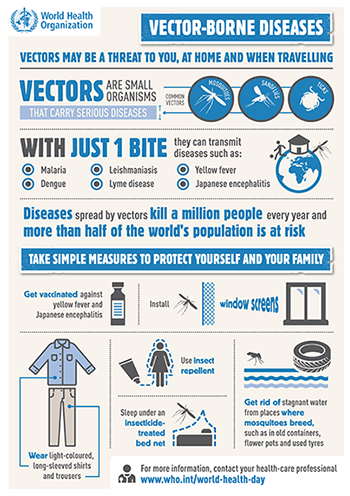World Health Day: Understanding vector-borne diseases
Today is World Health Day, and this year, the World Health Organization is focusing on the serious and increasing threat of vector-borne diseases with the slogan “small bite, big threat.”

According to the WHO, every year, more than one billion people are infected and more than one million die from vector-borne diseases.
Melissa Nolan Garcia with the National School of Tropical Medicine at Baylor College of Medicine explains vector-borne diseases and the research being done at Baylor to prevent them.
What are vector-borne diseases?
Vector-borne diseases are pathogens transmitted to humans by small organisms. Vectors include mosquitos, ticks, fleas, kissing bugs, lice, sandflies and more. Disease transmission normally occurs when the insect feeds on the human host. During the blood meal, the pathogen is transferred from the infected vector to humans.
What health problems can they cause?
Vector-borne diseases are a wide range of bacterial, parasitic and viral infections that can cause morbidity and mortality in humans.
The most common vector-borne diseases in Texas include West Nile virus, Chagas disease, and Murine typhus. West Nile virus is a viral disease transmitted to humans by mosquitos. In a small percentage of cases, it causes neuro-invasive disease that can result in lifelong disability. Chagas disease is a parasitic disease transmitted to humans by the kissing bug. It causes cardiomyopathy (enlargement of the heart), conduction abnormalities (abnormal beating of the heart) and heart failure in a third of those infected. Murine typhus is a bacterial infection transmitted to humans by fleas. It also causes neurologic infection that can be fatal in a small number of cases.
Potential emerging vector-borne diseases in the United States include Dengue and Chikungunya. Dengue is a viral infection transmitted by mosquitoes. It can cause a painful “break bone” fever, septic shock, and hemorrhagic fever (multi-organ syndrome). Chikungunya is also a viral infection transmitted by mosquitoes. It causes a severe arthritis that can cause lifelong disability in those infected.
What can you do to avoid them?
The best way to avoid vector-borne diseases is to prevent the attachment of the vector to your body. Methods of prevention include wearing long sleeves and pants, using insect repellent and installing window screens.
What research are you working on related to vector-borne diseases?
Our research focuses on understanding the disease burden of Texas vector-borne diseases and the development of vaccines.
Current studies include:
- Looking at the long-term effects of West Nile virus infection on the nervous system and kidneys.
- Screening febrile Houston area children for Dengue and Chikungunya.
- Performing transmission studies on Chagas disease positive blood donors.
- Describing the epidemiology of Murine typhus in Texas.
– Melissa Nolan Garcia, M.P.H., Research associate and Ph.D. candidate in the National School of Tropical Medicine at Baylor College of Medicine


